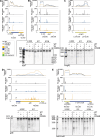The role of the 5' sensing function of ribonuclease E in cyanobacteria
- PMID: 38469716
- PMCID: PMC10939160
- DOI: 10.1080/15476286.2024.2328438
The role of the 5' sensing function of ribonuclease E in cyanobacteria
Abstract
RNA degradation is critical for synchronising gene expression with changing conditions in prokaryotic and eukaryotic organisms. In bacteria, the preference of the central ribonucleases RNase E, RNase J and RNase Y for 5'-monophosphorylated RNAs is considered important for RNA degradation. For RNase E, the underlying mechanism is termed 5' sensing, contrasting to the alternative 'direct entry' mode, which is independent of monophosphorylated 5' ends. Cyanobacteria, such as Synechocystis sp. PCC 6803 (Synechocystis), encode RNase E and RNase J homologues. Here, we constructed a Synechocystis strain lacking the 5' sensing function of RNase E and mapped on a transcriptome-wide level 283 5'-sensing-dependent cleavage sites. These included so far unknown targets such as mRNAs encoding proteins related to energy metabolism and carbon fixation. The 5' sensing function of cyanobacterial RNase E is important for the maturation of rRNA and several tRNAs, including tRNAGluUUC. This tRNA activates glutamate for tetrapyrrole biosynthesis in plant chloroplasts and in most prokaryotes. Furthermore, we found that increased RNase activities lead to a higher copy number of the major Synechocystis plasmids pSYSA and pSYSM. These results provide a first step towards understanding the importance of the different target mechanisms of RNase E outside Escherichia coli.
Keywords: 5’ sensing; RNA degradation; RNA-seq; RNase E; Synechocystis; cyanobacteria; tRNA maturation.
Conflict of interest statement
No potential conflict of interest was reported by the author(s).
Figures






References
MeSH terms
Substances
LinkOut - more resources
Full Text Sources
Other Literature Sources
Molecular Biology Databases
